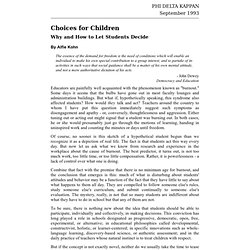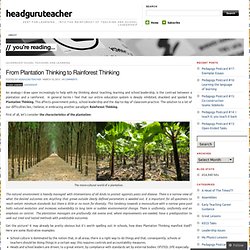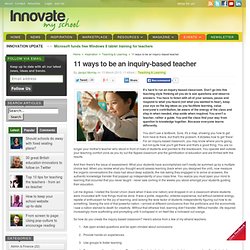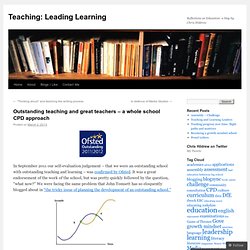

Choices for Children. September 1993 Choices for Children Why and How to Let Students Decide By Alfie Kohn The essence of the demand for freedom is the need of conditions which will enable an individual to make his own special contribution to a group interest, and to partake of its activities in such ways that social guidance shall be a matter of his own mental attitude, and not a mere authoritative dictation of his acts. - John DeweyDemocracy and Education Educators are painfully well acquainted with the phenomenon known as "burnout.

" Of course, no sooner is this sketch of a hypothetical student begun than we recognize it as a depiction of real life. Combine that fact with the premise that there is no minimum age for burnout, and the conclusion that emerges is this: much of what is disturbing about students' attitudes and behavior may be a function of the fact that they have little to say about what happens to them all day. The irony is enough to make us wince. 1. 2. 3. The evidence goes on and on. 4. 5. From Plantation Thinking to Rainforest Thinking. An analogy I draw upon increasingly to help with my thinking about teaching, learning and school leadership, is the contrast between a plantation and a rainforest.

In general terms I feel that our entire education system is deeply inhibited, shackled and spoiled by Plantation Thinking. This affects government policy, school leadership and the day-to-day of classroom practice. The solution to a lot of our difficulties lies, I believe, in embracing another paradigm: Rainforest Thinking. First of all, let’s consider the characteristics of the plantation: The mono-cultural world of a plantation. The natural environment is heavily managed with interventions of all kinds to protect againsts pests and disease. Get the picture? Gosh, just writing this, I’m feeling horribly claustrophobic…oppressed….caged.
Let’s think about the alternative. The lush rainforest; diverse, unpredictable, evolving, daunting, exciting. From Plantation Thinking to Rainforest Thinking: it’s quite a journey 1. 11 ways to be an inquiry-based teacher. It's hard to run an inquiry-based classroom.

Don't go into this teaching style thinking all you do is ask questions and observe answers. You have to listen with all of your senses, pause and respond to what you heard (not what you wanted to hear), keep your eye on the big ideas as you facilitate learning, value everyone's contribution, be aware of the energy of the class and step in when needed, step aside when required.
You aren't a teacher, rather a guide. You and the class find your way from question to knowledge together. Because everyone learns differently. You don't use a textbook. And then there's the issue of assessment. Let me digress. So how do you create the inquiry-based classroom? Ask open-ended questions and be open-minded about conclusionsProvide hands-on experiencesUse groups to foster learningEncourage self-paced learning. In the end, know that inquiry-based teaching is not about learning for the moment. How do you ensure they are ready? Creating Classrooms We Need: 8 Ways Into Inquiry Learning. If kids can access information from sources other than school, and if school is no longer the only place where information lives, what, then happens to the role of this institution?

“Our whole reason for showing up for school has changed, but infrastructure has stayed behind,” said Diana Laufenberg, who taught history at the progressive public school Science Leadership Academy for many years. Laufenberg provided some insight into how she guided students to find their own learning paths at school, and enumerated some of these ideas at SXSWEdu last week. 1. BE FLEXIBLE. The less educators try to control what kids learn, the more students’ voices will be heard and, eventually, their ability to drive their own learning. Laufenberg recalled a group of tenacious students who continued to ask permission to focus their video project on the subject of drugs, despite her repeated objections. 2. Laufenberg’s answer: Get them curious enough in the subject to do research on their own.
Outstanding teaching and great teachers – a whole school CPD approach. In September 2011 our self-evaluation judgement – that we were an outstanding school with outstanding teaching and learning – was confirmed by Ofsted.

It was a great endorsement of the work of the school, but was pretty quickly followed by the question, “what now?” We were facing the same problem that John Tomsett has so eloquently blogged about in “the tricky issue of planning the development of an outstanding school.” Our priority – as at Huntingdon – is to keep the main thing the main thing and continue to develop our outstanding teaching and learning. I believe it is essential that every teacher in every school should aim to be outstanding – what David Didau calls perfection. The approach we have taken is partly born out of the “grace period” that the outstanding judgement has given us; we know that inspectors won’t be knocking on our door this academic year. If there was no OfSTED, no league tables, no SLT… just you and your class..what would you choose to do to make it GREAT?
A formulaic approach. Outstanding-lessons-introduction. Julia Li: The Rebirth of Learning Starts With Mindset.